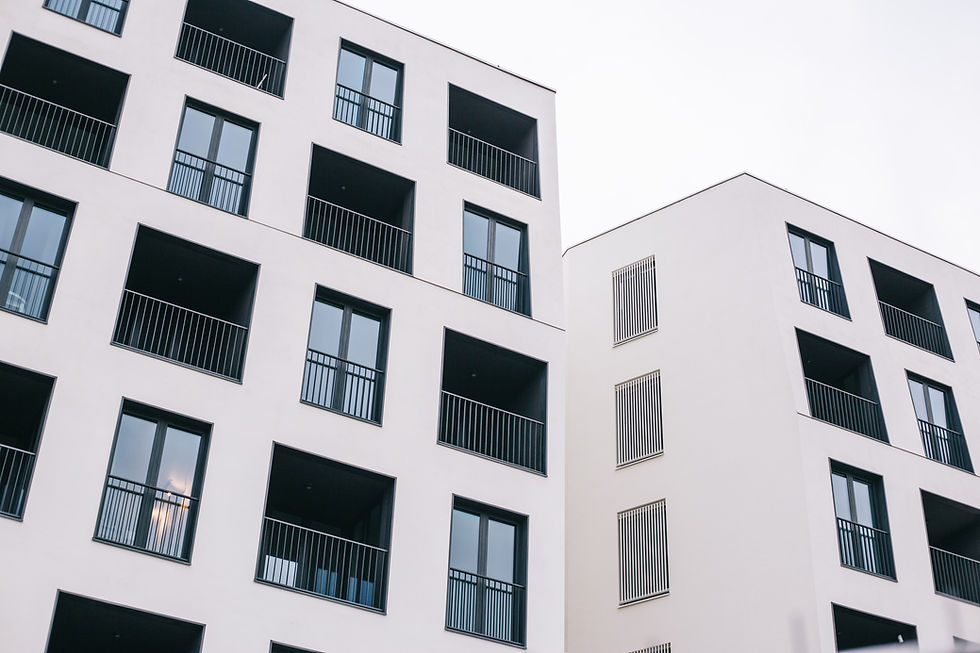Multifamily Investing: The Definitive 11-Step Guide to Buying, Financing & Scaling Apartment Assets
- NCC IQ

- Aug 10
- 7 min read
Multifamily property fills an undeniable human need, shelter, while offering uncommon durability in cash-flow. Households migrate, jobs wax and wane, yet renters still renew leases every month. That combination of utility and repeat income explains why pension funds, life-insurance companies, and global sovereign vehicles keep expanding allocation to apartments. Cap rates on core U.S. assets averaged 4.83% in Q1 2025 after compressing six basis points from the prior quarter, even though the 10-year Treasury hovered near 3¾ percent.
Vacancy Followed Suit
CBRE’s first-quarter figure dropped to 4.8 percent nationally as fresh absorption out-paced record new supply. Short-term rent growth cooled - CBRE pegs 2024’s gain at 1.2 percent, yet Yardi projects a rebound to 1.5% for 2025 as construction starts fall and job creation revives.

Those data points tell a simple story: apartments remain liquid, lenders still compete for well-underwritten deals, and disciplined operators can ride a long runway. The article that follows distills the process into eleven sequential stages, each one practical, brief, and free of jargon.
Step 1: Define Your Targets
Every portfolio begins with motive.
Are you chasing durable income for family wealth?
Targeting forced-appreciation flips?
Building a regional operating company?
Write the purpose down, attach time frames, then assign numeric thresholds - cash-on-cash, internal rate of return, equity multiple. The list will keep acquisitions aligned and protect you from chasing shiny objects when brokers flood your inbox.
Questions worth sharpening:
Hold period - five-year recycle or generational?
Preferred yield - do limited partners expect quarterly distributions or a backend payoff?
Risk band - core, core-plus, value-add, or opportunistic?
With a documented brief, you can share clear direction with lenders and limited partners, accelerating trust.
Metric | 2025 YTD figure | Context |
Average advertised asking rent | $1,749 | June reading; +0.9 % YoY, +1.2% during H1 2025. |
Occupancy rate | 95.7% | May reading; up 90 bps since January. |
Completions, H1 2025 | ≈ 224,200 units | 116k Q1 2025 + 108.2k Q2 2025. |
Full-year 2025 completions (forecast) | ≈ 431,000 units | RealPage projection; -26% vs. 2024. |
Core going-in cap rate (Q1) | 4.83% | -6 bps quarter-on-quarter. |
Core exit cap rate (Q1) | 5.00% | -3 bps quarter-on-quarter. |
Net absorption, Q1 | 138,000 units | Record first-quarter total. |
Effective rent growth, full-year outlook | ≈ 2.3% | RealPage forecast for calendar 2025. |
Step 2: Decode Macro & Micro Drivers
National headlines matter, Federal Reserve pauses, jobless claims, household formation, but apartments trade block by block. Map supply pipelines, transit options, university expansions, zoning revisions, and employer relocations.
Supply pulse: CBRE counted 440,000 units scheduled for delivery in 2024. Track whether cranes cluster around your target submarket or tilt toward a rival city.
Demand magnets: Hospitals, state capitals, major logistics nodes, and technology corridors pull graduates and immigrants permanently.
Public policy: Inclusionary zoning or rent caps can change pro-forma margins overnight.
Macro Drivers - United States 2025 YTD
Payroll momentum: The economy added 456,000 seasonally-adjusted jobs in Q1—the lightest first-quarter advance since 2011, yet more than enough to support household formation.
Benchmark financing cost: The 10-year Treasury hovered near 4.35% in early July, framing the risk-free floor for permanent debt.
New‐unit deliveries: Roughly 116,000 apartments came online in Q1; RealPage projects ≈ 431,000 for all of 2025, a 26% slide from 2024’s peak.
National occupancy: Market-rate properties averaged 95.7% in May, up 90 bps since January as leasing season gathered speed.
Average advertised rent: Yardi Matrix logged $1,749 in June, a 0.9 % year-over-year bump.
Core going-in cap rate: CBRE’s Q1 survey placed institutional-quality deals at 4.83%, six basis points tighter quarter-to-quarter.
Effective-rent outlook: RealPage expects ≈ 2.3% growth for calendar 2025, with 60% of large metros clustering between 2% and 4%.
Blend top-down and street-level intelligence; the result will shape underwriting assumptions in Step 6.
Step 3: Craft an Investment Thesis
Choose a repeatable playbook:
Workforce housing preservation - buy 1980s-1990s stock at a discount to replacement cost, upgrade interiors, tuck in fiber-optic Wi-Fi, then reset rents to local median.
Core-plus suburban garden style - capture renters leaving downtown towers yet unwilling to buy homes amid mortgage-rate friction.
Mid-rise near universities - prime for partial furnished short-term leasing and strong renewal probability.
Tie the thesis to demographic evidence, not buzzwords. If data show inward migration to secondary Midwest metros, the thesis should reflect that, rather than chasing the latest Sun Belt craze.
Step 4: Assemble the Specialist Bench
Secure relationships with:
Mortgage banker fluent in agency, bridge, and structured products.
Attorney who closes at least twenty apartment transactions each year.
Insurance broker who understands habitational risk and water-infiltration clauses.
Property-management firm with onsite staff depth, resident-experience tech, and regional repair crews.
Cost-segregation person will help to accelerate depreciation schedules.
Interview three candidates per slot, insist on references, and arrange compensation so that incentives align with net operating income (NOI) growth.
Step 5: Build a Deal Pipeline
Off-market whispers are overrated unless you already own nearby assets.
Start with the public record:
Brokerage platforms - CBRE, JLL, Berkadia, Marcus & Millichap.
Auction sites - Ten-X, RealINSIGHT Marketplace.
Public deeds for expiring loans.

Track leads in a simple CRM.
Log deal size, vintage, occupancy, whisper price, broker contact, and response date. Over time, patterns emerge - certain brokers favor student housing, others handle distressed suburban product. That intelligence guides focused outreach.
Step 6: Master the Underwrite
Numbers tell true stories. Build a twelve-month pro-forma coupled with a ten-year discounted-cash-flow (DCF) model. Key guardrails:
Revenue:
Market rent growth no higher than trailing five-year average of the submarket (many analysts cap next-year growth near 2% given current supply).
Other income - pet fees, covered parking, trash valet, limited to services with proven uptake.
Expenses:
Payroll tied to unit count (one onsite employee per 90-100 units is common).
Property taxes trended to assessed value, particularly in nondisclosure states such as Texas.
Capital expenditures:
Reserve at least $300 per unit annually for replacements to stave off lender scrutiny.
Stress-test debt service coverage at 150-200 basis-point rate shocks. If the deal still clears a 1.20x ratio, you have cushion.
Step 7: Design the Capital Stack
Senior Debt
Agency lenders, Fannie Mae and Freddie Mac remain active, often at 65-75% LTV (Loan-to-Value) on stabilized assets. Their affordability bonuses lower spreads if a share of units rent at or below area median income.
Commercial banks fill gaps for smaller balance sheets, though many trimmed exposure after the 2024 regional bank turmoil. Private-credit funds stepped into that void, usually pricing 100-150 basis points above agencies yet offering higher leverage and fewer covenants.
Subordinate Layers
Preferred equity bridges big rehabs but comes with cash-flow sweeps if NOI falls short.
Common equity—your money plus limited partners—takes residual upside.
Blend sources so that weighted-average cost of capital remains below forecast unlevered IRR; otherwise leverage magnifies risk, not return.
Step 8: Conduct Diligence with Surgical Precision
Time kills deals, so run checklists in parallel:
Category | Actions |
Physical | Roof, plumbing, electrical panels, fire-life-safety, paving, unit interiors. |
Environmental | Phase I ESA, radon, asbestos, lead-based paint for pre-1978 stock. |
Operational | Lease audit, utility bills, maintenance logs, staff interviews. |
Legal | Zoning confirmation, code violations, litigation search. |
Push vendors to deliver reports ten days before contingencies expire; that leaves margin for renegotiation or re-trade.
Step 9: Negotiate and Close
Winning bid strategy extends beyond price.
Show certainty: provide proof of funds, clear timeline, and limited contingencies.
During purchase agreement drafting, fight for language that allocates latent structural issues to the seller or nets you credits at escrow. Constant communication with lender attorneys keeps loan docs moving in lockstep with title.
Final week checklist: order utility transfers, schedule insurance binder, circulate resident introduction letters, pre-fund repair escrows. The clock strikes midnight on closing day, and the asset joins your portfolio ready for Step 10.
Step 10: Operate Like an Institution
Asset management distinguishes owners who collect distributions from those who chase rent rolls. Implement quarterly operating reviews:
Budget variance analysis - line-item gap explanations, corrective actions.
Leasing velocity - daily traffic, conversion ratios, concession dollars.
Maintenance cycles - average work-order days, make-ready turns.
Resident sentiment - online reviews, renewal-intent surveys.

Pair metrics with tactile presence; walk the property monthly, photograph deferred items, and meet staff face-to-face. A culture of accountability anchors underwriting assumptions and keeps lenders confident.
Step 11: Scale & Recycle Capital
Growth in apartments rarely follows a straight line; it compounds when equity recycles. Three primary levers:
Supplemental loans - agency programs permit secondary debt once the property seasons for twelve months and reaches 1.30x debt-service coverage. Pull proceeds tax-deferred, redeploy into the next asset.
Cash-out refinance - if cap rates compress (remember the 4.83% average noted earlier) and NOI rises, new valuation unlocks senior debt at par or better than original basis.
Portfolio sale or partial recap - sell a minority stake to an institutional investor, retire partner capital, and retain management fees.
Plan those moves before closing the very first deal. Scaling is less about unit count bragging rights and more about repeatable systems that produce durable distributions.
Apartment assets sit at the intersection of real estate and people.
Spreadsheets matter, yet resident experience fuels renewal, and neighborhoods shape absorption. Follow the eleven-step blueprint, respect local data, stay disciplined on leverage, and your multifamily venture will hold its own against any economic season.
Credit: (CBRE, Yardi, RealPage)
No Offer or Solicitation
This communication is intended solely for informational and educational purposes. It does not constitute, and shall not be construed as, an offer, invitation, or solicitation to purchase, acquire, subscribe for, sell, or otherwise dispose of any real estate investments, securities, or related financial instruments. Nothing contained herein should be interpreted as a recommendation or endorsement of any specific investment strategy or opportunity. Furthermore, this communication does not represent, and shall not be deemed to constitute, the issuance, sale, or transfer of any real estate interests in any jurisdiction where such actions would be in violation of applicable laws, regulations, or licensing requirements.
About NCC IQ
NCC IQ is the official real estate eLearning platform of NCC (Northstar Capital & Co.), developed to support the ongoing education and advancement of industry professionals. The platform offers a robust mix of premium and complimentary resources—including on-demand videos, live virtual events, industry podcasts, eBooks, and expert-authored articles—designed to deliver actionable insights and practical tools. Stay informed by following us on LinkedIn and Instagram for the latest educational content and market updates.



















Comments